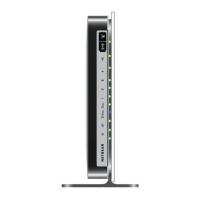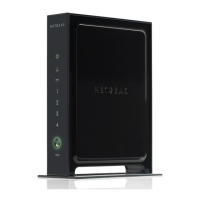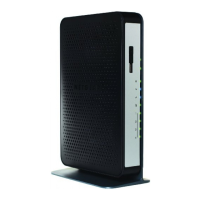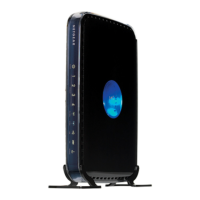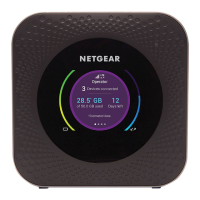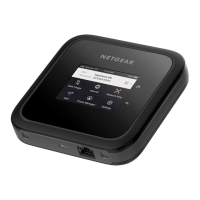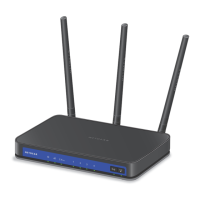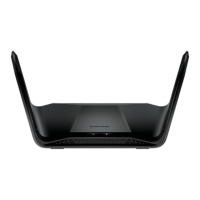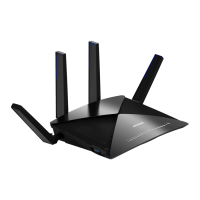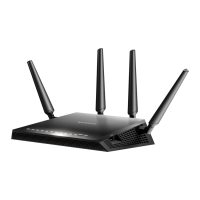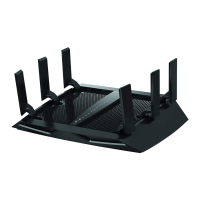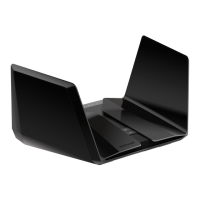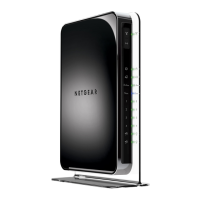
Do you have a question about the NETGEAR N900 and is the answer not in the manual?
| Wireless Standard | 802.11 a/b/g/n |
|---|---|
| Number of Ethernet Ports | 4 |
| Security | WPA/WPA2 |
| Frequency Band | 2.4 GHz and 5 GHz |
| WiFi Speed | 450+450 Mbps |
Unpack the router, cables, and installation guide to check package contents.
Optimize wireless signal range by placing the router in an open, elevated location.
Familiarize with the router's front and back panels, paying attention to status LEDs and icons.
Overview of the router's front panel status LEDs and icons for power, internet, and wireless.
Details the connections and buttons on the rear of the router, including ports and reset button.
Information on the router label, including serial number, MAC address, preset SSID, and WiFi password.
Gather necessary ISP information and ensure devices are ready for router setup.
Understand the different login types: router login, ISP login, and wireless network key.
Automated router setup process using the NETGEAR genie web interface, taking about 15 minutes.
Access and manage router settings via the NETGEAR genie interface after initial setup.
Check for and install the latest firmware updates for the router to improve performance and security.
View network status at a glance and access various router settings via the dashboard interface.
Connect wireless devices manually or using WPS for easy network access.
Manage, monitor, and repair your home network using the NETGEAR genie mobile application.
Configure and view your router's Internet connection settings, including ISP information.
View a list of all computers and devices currently connected to your network.
Set up parental controls to manage and restrict internet content for connected devices.
Access and manage USB storage devices connected to the router's USB port.
Configure basic wireless network settings, including SSID, security options, and passphrase.
Set up a separate guest network for visitors to access the internet without compromising main network security.
Step-by-step guide to automatically configure the router's internet connection and network settings.
Easily add WPS-capable devices to your wireless network using the WPS button or PIN method.
Access various setup configurations including Internet, Wireless, Guest Network, WAN, LAN, and QoS.
Configure Wide Area Network (WAN) settings, including DMZ, MTU size, and NAT filtering.
Configure Local Area Network (LAN) settings, including IP address, subnet mask, and DHCP server.
Prioritize network traffic for specific applications, games, or devices to improve performance.
Specifications for USB drive compatibility, including supported standards, file systems, and speed.
Share USB storage contents across your network using methods like \readyshare.
Explore various uses for USB drive sharing, including multimedia sharing and remote access.
View or edit basic settings for the USB storage device attached to your router.
Configure advanced settings for USB storage, including network device name, workgroup, and access methods.
Properly disconnect USB drives from the router to prevent data loss or corruption.
Configure the router as a DLNA media server to stream content to compatible devices.
Enhance security by configuring the router to share only specific, approved USB devices.
Access the USB drive remotely using the router's Internet IP address or a Dynamic DNS name.
Enable remote access over the internet to USB storage devices connected to your router.
Configure Time Machine for automatic backups of Mac computers to a connected USB hard drive.
Access the USB hard drive from your Mac computer for Time Machine backups.
Ensure the USB drive's partition scheme is GUID or MBR for compatibility with the router.
Connect a USB printer to the router and share it wirelessly among network computers.
Install and use the utility to control shared USB devices like printers, scanners, or speakers.
Configure the USB Control Center utility, including automatic startup, timeout, and language settings.
Connect and use a USB printer through the router, managing driver installation and status.
Utilize the scanning feature of a multifunction printer connected to the router.
Connect and control USB speakers through the router for audio playback.
Prevent specific keywords or domains from accessing your network via HTTP traffic blocking.
Block specific internet services or applications by configuring port filtering rules.
Specify days and times to block internet access or specific services for enhanced control.
Configure email alerts for security events like blocked site access or system logs.
Update the router's firmware to the latest version for improved performance and security.
Monitor router status, hardware/firmware versions, and network port information.
View and configure wireless network settings for both 2.4 GHz and 5 GHz bands.
Configure guest network settings for both 2.4 GHz and 5 GHz bands for visitor access.
Review logs of accessed or attempted website visits, useful for security monitoring.
Back up, restore, or erase router configuration settings for management and recovery.
Change the router's administrator login password for enhanced security.
Configure advanced wireless features like signal scheduling, WPS, and MAC address access lists.
Set up the router as a wireless repeater or access point to extend network coverage.
Create exceptions for inbound traffic to allow specific applications or servers access.
Understand how remote access works and the role of port forwarding and triggering.
Configure port triggering to dynamically open inbound ports based on outbound traffic.
Configure port forwarding to allow external devices to access local network servers.
Compare port forwarding and port triggering, noting their differences in configuration and use.
Forward specific incoming protocols to local network servers like web or FTP servers.
Configure port triggering rules, including service name, protocol, and port numbers.
Set up Dynamic DNS to access your router using a domain name with a changing IP address.
Configure static routes for advanced network configurations involving multiple routers or IP subnets.
Enable remote access to manage and check the status of your router over the internet.
Configure settings for approved USB devices for enhanced security.
Enable UPnP for automatic device configuration and network discovery.
Set up an IPv6 internet connection type if it is not automatically detected.
Monitor internet traffic volume, set limits, and receive live updates on usage.
Provides general tips for troubleshooting common router and network problems.
Diagnose router issues by interpreting the status of front panel LEDs.
Troubleshoot issues when the router's Power/Test LED is off or blinking.
Resolve problems when the Power/Test LED remains amber after router startup.
Troubleshoot situations where router LEDs remain on continuously after power-up.
Diagnose issues when the Internet or Ethernet port LEDs are not lit.
Check wireless connectivity issues if the router's wireless LEDs are off.
Troubleshoot WPS connection issues when the WPS button blinks amber.
Resolve issues preventing login to the router's administrative interface.
Troubleshoot problems preventing internet access even when the router is accessible.
Steps to troubleshoot PPPoE internet connection problems.
Resolve issues with loading web pages after obtaining an IP address.
Ensure configuration changes are saved by clicking 'Apply' and clearing browser cache.
Isolate and fix problems with connecting to the router's wireless network.
Improve weak wireless signal strength by checking router placement and obstructions.
Reset the router to factory defaults to resolve configuration issues or forgotten passwords.
Use the ping utility to diagnose network connectivity issues to devices.
Verify the local network path to the router by pinging its IP address.
Test network connectivity from your computer to a remote device like an ISP DNS server.
Details the default configuration settings for the router, including login, network, and firewall.
Provides detailed technical specifications for the router, including hardware, wireless, and environmental data.
User requirements for operating radio devices, including regional firmware limits.
Information regarding FCC rules, human exposure guidelines, and declaration of conformity.
Guidance on FCC compliance, potential interference, and user precautions.
Information on Canadian radio interference regulations and Class B digital apparatus limits.
Compliance information for Industry Canada, including interference acceptance and operational failure notes.
